![]()
![]()
![]()
Use LEFT and RIGHT arrow keys to navigate between flashcards;
Use UP and DOWN arrow keys to flip the card;
H to show hint;
A reads text to speech;
58 Cards in this Set
- Front
- Back
- 3rd side (hint)
|
Eublepharis macularius |

Leopard Gecko |
It has five officially recognized subspecies. |
|
|
Gekko gecko |

Tokay Gecko |
It is considered the second-largest gecko species in the world. |
|
|
Alligator mississippiensis |

American Alligator |
The smaller an individual of this species is, the more likely it is to be found in wetlands, where it uses the plant life as a means of protection from predators. |
|
|
Glyptemys insculpta |
Wood Turtle |
|
|
|
Glyptemys insculpta |

Wood Turtle |
Most eggs never hatch; nest predation by raccoons, skunks, shrews, foxes, and other predators can typically result in high losses. |
|
|
Tarentola mauritanica |

Moorish Gecko |
It has a spiky look due to the bumps across its body, also known as tubercles. |
|
|
Podarcis muralis |

Common Wall Lizard |
Hibernation is from November until March or April and is often interrupted during warmer spells. |
|
|
Lacerta bilineata |
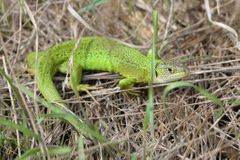
Western Green Lizard |
The mating ritual is precise, and starts with a bite to the base of the female's tail. |
|
|
Timon lepidus |

Ocellated Lizard |
This reptile is the embodiment of a cellular automaton, a type of discretized model made popular by John Conway’s Game of Life and used to simulate the spread of wildfires, the firing of neurons, and other phenomena. |
|
|
Malpolon monspessulanus |

Montpellier Snake |
This snake is one of the back-fanged colubrids which have a certain venomous capability, though the back position of the venom fangs means injection is unusual. |
|
|
Hemorrhois hippocrepis |

Horseshoe Whip Snake |
The smooth dorsal scales are arranged in 25-29 rows, and the ventrals number 220-258. |
|
|
Natrix maura |

Viperine Snake |
It is known to strike like an adder, but not bite; however, when in water, it then looks like a grass snake and hunts its prey in the same way. |
|
|
Macroprotodon brevis |

Western False Smooth Snake |
This species is a specialist predator of amphisbaenians (Blanus sp.) and skinks. |
|
|
Blanus cinereus |

Iberian Worm Lizard |
It is often found in moist, sandy soils that are easy to burrow in and have a high level of humus. |
|
|
Psammodromus algirus |
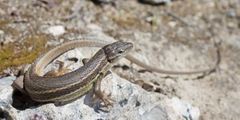
Algerian Psammodromus |
Females lay between 8 and 11 eggs. |
|
|
Coronella girondica |

Southern Smooth Snake |
On the nape there is a dark U-shaped mark, or a pair of dark elongate spots. |
|
|
Psammodromus hispanicus |
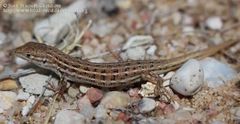
Spanish Psammodromus |
Molecular clock dating, together with population genetic analyses, indicate that the three lineages from which this species diverged experienced northward range expansions from southern Iberian refugia during Pleistocene glacial periods. |
|
|
Chalcides bedriagai |

Bedriaga's Skink |
Females of this species give birth to live young. |
|
|
Chalcides chalcides |

Italian Three-toed Skink |
It is threatened by urbanization and the degradation of its habitat by coastal development, but it is tolerant of some degree of habitat modification. |
|
|
Coluber constrictor |
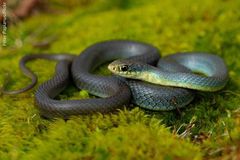
Eastern Racer |
They are curious, with excellent vision and are sometimes seen raising their heads above the height of the grass where they are crawling to view what is around them. |
|
|
Malayopython reticulatus |

Reticulated Python |
The world's longest snake. |
|
|
Eunectes murinus |
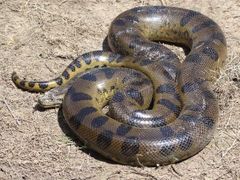
Green Anaconda |
Females of this species will usually, after mating, eat one or two males because after that those females will stay without food for about 7 months. |
|
|
Boa constrictor |
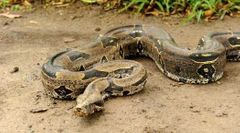
Boa Constrictor |
Nine subspecies are recognized. |
|
|
Chelonoidis nigra |

Galapágos Tortoise |
Members of this species often live to be over a hundred years old. |
|
|
Amblyrhynchus cristatus |

Marine Iguana |
The divergence between this species and its land-living relatives has been estimated at 10.5 million years ago. |
|
|
Conolophus subcristatus |

Galapágos Land Iguana |
Charles Darwin described them as "ugly animals, of a yellowish orange beneath, and of a brownish-red colour above: from their low facial angle they have a singularly stupid appearance." |
|
|
Conolophus pallidus |

Santa Fe Land Iguana |
Because fresh water is scarce on the islands they inhabit, members of this species obtain the majority of their moisture from the prickly-pear cactus that makes up 80% of their diet. |
|
|
Ctenosaura palearis |
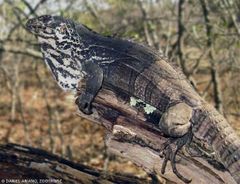
Motagua Spiny-tailed Iguana |
An endangered species. |
|
|
Ctenosaura hemilopha |

Cape Spiny-tailed Iguana |
The San Esteban Island subspecies (C. h. conspicuosa) coexists with the giant San Esteban chuckwalla, contrary to predictions of ecological niche theory. |
|
|
Ctenosaura hemilopha |
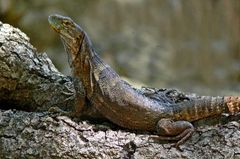
Cape Spiny-tailed Iguana |
The San Esteban Island subspecies (C. h. conspicuosa) coexists with the giant San Esteban chuckwalla, contrary to predictions of ecological niche theory. |
|
|
Ctenosaura acanthura |

Northeastern Spiny-tailed Iguana |
They are diurnal and fast moving, employing their speed to escape predators but will lash with their tails and bite if cornered. |
|
|
Ctenosaura melanosterna |

Black-chested Spiny-tailed Iguana |
The population is less than 5,000 individuals among 2 range areas, making it an endangered species. |
|
|
Ctenosaura bakeri |
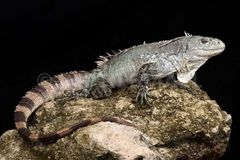
Utila Spiny-tailed Iguana |
It is the only species of iguana and one of only two species of lizard to exclusively inhabit brackish mangrove swamps, forced there due to competition from larger species. |
|
|
Ctenosaura defensor |
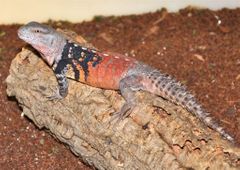
Yucatán Spiny-tailed Iguana |
A foot-long specimen was found scurrying across a loading dock on July 29, 2010 at Ford Motor Co.'s Van Dyke Transmission Plant in Sterling Heights, Michigan, and was a stowaway in auto parts crates shipped from the Yucatán peninsula in Mexico. |
|
|
Ctenosaura flavidorsalis |

Yellow-backed Spiny-tailed Iguana |
The holotype was SMF 75845, male. |
|
|
Tupinambis teguixin |

Gold Tegu |
To tell the difference between this species and the Argentine, look between the eye and the nostril (the loreal scale); if there is one scale, you have this species, and if it has two scales, you have an Argentine. |
|
|
Varanus exanthematicus |

Savannah Monitor |
Until 1989, the White-throated Monitor and this species were considered to be the same species. |
|
|
Varanus prasinus |
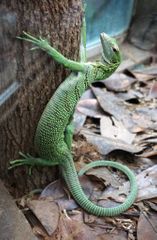
Emerald Tree Monitor |
It is known for its unusual coloration, which consists of shades from green to turquoise, topped with dark, transverse dorsal banding. |
|
|
Varanus indicus |

Mangrove Monitor |
It has created a nuisance on many islands preying on domesticated chickens and scavenging the eggs of endangered sea turtles. |
|
|
Varanus melinus |

Quince Monitor |
Only known to science since 1997, its wild habits remain mysterious. |
|
|
Varanus jobiensis |

Peach-throated Monitor |
It is hunted for human consumption in New Guinea. |
|
|
Varanus auffenbergi |

Peacock Monitor |
They are calm and shy compared to other monitor lizards. |
|
|
Varanus glauerti |
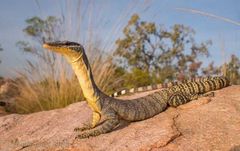
Kimberley Rock Monitor |
V. glauerti lives almost exclusively on rocky cliff faces, but is found in humid forests. |
|
|
Varanus gilleni |

Pygmy Mulga Monitor |
The nostrils are positioned on the sides of the muzzle, about halfway between the tip of the snout and the eye. |
|
|
Varanus brevicauda |
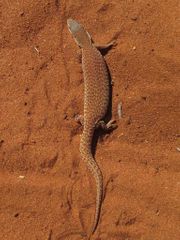
Short-tailed Pygmy Monitor |
It is the second smallest living monitor lizard in the world with a maximum length of 25 cm. |
|
|
Varanus mitchelli |
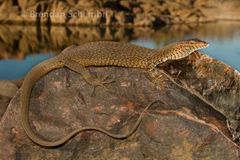
Mitchell's Water Monitor |
In captivity, it is reported to be very nervous and shy. |
|
|
Varanus glebopalma |

Black-palmed Rock Monitor |
This varanid is secretive, eluding casual observers and poorly recorded in surveys. |
|
|
Varanus rosenbergi |
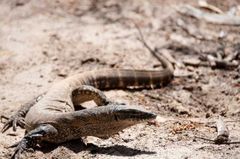
Rosenberg's Monitor |
In February and March, the female digs into an active termite mound, creating a spherical nest chamber beneath the hardened shell—found under the loose outer layer of the mound—by collapsing the internal structure of tunnels and chambers. |
|
|
Varanus pilbarensis |
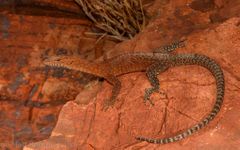
Pilbara Rock Monitor |
Like other rock dwelling varanids in the Pilbara region, one of around ten species in the herpetological "hotspot", the population has become geographically isolated and diverged as a distinguishable genetic lineage. |
|
|
Chelonia mydas |
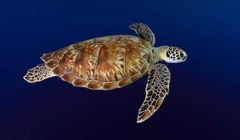
Green Sea Turtle |
The only herbivore of its family. |
|
|
Eretmochelys imbricata |
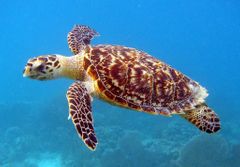
Hawksbill Sea Turtle |
Unique to this species is a pair of claws on each flipper. |
|
|
Chelus fimbriata |

Mata Mata |
Its name means "kill, kill" in Spanish. |
|
|
Macrochelys temminckii |

Alligator Snapping Turtle |
The average lifespan is 80-100 years. |
|
|
Sistrurus miliarius |

Pygmy Rattlesnake |
This is the smallest rattlesnake in the US. |
|
|
Uromastyx acanthinura |

Bell's Dabb Lizard |
Individuals are known to live for 11.4 years. |
|
|
Pogona henrylawsoni |

Rankin's Dragon |
It has only been a defined species since the 1980s. |
|
|
Pogona minor |

Western Bearded Dragon |
Like other Pogona species, they will wave one of their fore legs to trigger a response from a potential rival or mate. |
|
|
Pogona barbata |
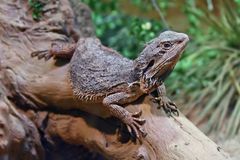
Eastern Bearded Dragon |
This species was originally described in 1829 by Georges Cuvier, who named it Amphibolurus barbatus. |

